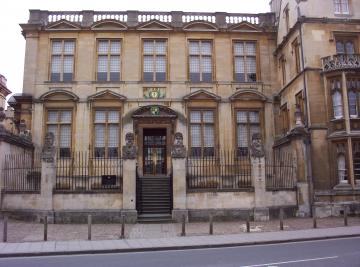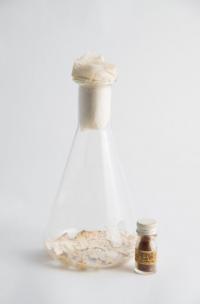The History of Science, Medicine, and Technology at Oxford
A major part of the work of Oxford Modern History Faculty is to promote specialist study of areas not traditionally covered in the undergraduate syllabus and college teaching. One of the most significant and well-established of these disciplines, now fully integrated into both graduate and undergraduate studies, is the History of Science, Medicine, and Technology. Professor Robert Fox describes this achievement.
The history of science came early to Oxford. Its first champion was Robert T. Gunther, the son of a keeper of zoology at the British Museum and a graduate of Magdalen who became a notable zoologist. As college lecturer in natural science at Magdalen from 1894 until his retirement, at the age of 50, in 1920, Gunther showed himself to be a fighter, both for the cause of science in the University and for the preservation of Oxford’s scientific heritage. His first work, A History of the Daubeny Laboratory (1900), reflected his devotion to the memory of the laboratory’s founder and Magdalen’s greatest man of science, Charles Daubeny, who had held chairs of chemistry, botany, and rural economy at various times in the mid-nineteenth century. A supplement, The Daubeny Laboratory Register, followed in 1916, but it was his Early Science in Oxford, published in fourteen meticulously researched volumes between 1923 and 1945, that signalled his definitive move from science to history.
The First World War brought home to Gunther the vulnerability of Oxford’s scientific collections, in particular the many early instruments that survived, largely disregarded, in the colleges. The gem, for Gunther, was the Orrery Collection in Christ Church, a cabinet of mathematical and scientific apparatus dating from c.1700. But the first three volumes of Early Science in Oxford (1923–5) bear witness to the sheer quantity of instruments, specimens, and records that Gunther had inventoried, ranging from the medieval astrolabes at Merton to the anatomical, geological, and other historic collections that were still being added to in the early twentieth century. Once the finest of the instruments had been displayed in the Bodleian in 1919, no one could doubt the richness of Gunther’s finds, and, with the bit now firmly between his teeth, he turned to the search for a permanent location, not only for the objects shown in the Bodleian but also for those that had now been offered to the university by the private collector Lewis Evans, the brother of the archaeologist Sir Arthur Evans.
The home that Gunther coveted was the Old Ashmolean Building in Broad Street, which had been used for a miscellany of purposes since the opening of the Ashmolean Museum’s new premises in Beaumont Street in 1894. Opposition to Gunther’s plan, notably from the Keeper of the Ashmolean, D. G. Hogarth, was strong, and it required a combination of the tenacity of Gunther and Evans, the offer of £1000 by the Goldsmiths’ Company, and an intervention by Lord Curzon to win the day. In 1905, the upper floor of the Old Ashmolean Building was inaugurated for the display of the assembled collections, and after another ten years, punctuated by friction of every kind, the whole building was finally opened as the Museum of the History of Science that it is today.[1]

The museum has been directed by a succession of eminent scholarly curators: Gunther, Frank Sherwood Taylor, C. H. Josten, Francis Maddison, and, currently, Jim Bennett. Under them and some distinguished assistant curators, among them Gerard Turner, Will Ryan, John North, Willem Hackmann, and Stephen Johnston, it has established its reputation as a world-class resource for research in the history of instruments. Apart from occasional lectures, notably by Taylor and the historian and chemist Stephen Mason, however, teaching in the history of science did not begin in Oxford until 1953, when Alistair Crombie moved from University College, London to become the university’s first lecturer in the history of science. Crombie had begun his academic career as a physiologist, but his main historical interests extended across the whole range of the sciences and philosophy in the medieval and early modern periods. His Augustine to Galileo (1952) and Robert Grosseteste and the Origins of Experimental Science 1100–1700 (1953) elaborated his core perception of the elements of continuity between medieval discussions of scientific method and those that fed into the new philosophy of the seventeenth century. Under Crombie, the history of science was added to the Modern History Faculty’s offerings at graduate level, and in 1965 the special subject on ‘The scientific movement in the seventeenth century’ was offered to undergraduate historians for the first time. That special subject, currently taught by Jill Lewis and John Robertson, is still a popular choice.
The early 1970s saw a significant strengthening of the subject, with the creation of a chair in the history of science and a readership in the history of medicine. The appointment of Margaret Gowing to the chair caused surprise in some circles. After training as an economic historian at the London School of Economics, Gowing had entered the civil service, where from 1945 she worked under Sir Keith Hancock on the civil history of the Second World War, a project that ran to 27 volumes, including two jointly authored by Gowing. However, it was as historian and archivist to the United Kingdom Atomic Energy Authority and later as reader in contemporary history at the University of Kent that Gowing pursued her most notable research. Her Britain and atomic energy, 1939–1945 (1964) and the two volumes of her Independence and Deterrence. Britain and Atomic Energy, 1945–1952 (1974) were written in these years, establishing her as the outstanding historian of Britain’s engagement, civil and military, in atomic energy. Arriving in Oxford in 1973, she found it hard to promote the kind of history she did within the Modern History Faculty, and she always stood somewhat apart from Faculty affairs. Her main affection in Oxford was for her college, Linacre, and much of her energy was expended on the establishment of the Contemporary Scientific Archives Centre, to which the papers of eminent scientists were brought from all over the country for cataloguing before being deposited in whatever was the most appropriate university or other institutional archive. It was a great loss to Oxford when, following Gowing’s retirement in 1986, the centre moved to the University of Bath, where it continues its work.
The readership in the history of medicine brought another outstandingly gifted historian to Oxford: Charles Webster. At the University of Leeds, Webster had laid the foundations for his monumental study of the Baconian tradition in seventeenth-century science, The Great Instauration. Science, Medicine, and Reform, 1626–1660 (1975). In Oxford, he combined his research and teaching on early modern science with a parallel commitment to the history of the National Health Service. The three volumes of his history that appeared between 1988 and 1998 stand as enduring testimony to the intensity of Webster’s engagement and his deftness in the writing of an immensely complex institutional study.
As reader, Webster also directed the Wellcome Unit for the History of Medicine from its foundation in 1972. Thirty years on, the unit remains a leading contributor to the Faculty’s profile in research and a major focus for external research funding. After Webster’s departure to a Senior Research Fellowship at All Souls in 1988, successive directors – Richard Smith, Jane Lewis, and Mary Dobson – placed their stamp on the unit, which is now, under Mark Harrison, reader and director since 2001, devoted mainly to the history of tropical medicine and infectious diseases. Scholars at the unit are currently engaged in a wide variety of projects within this broad area, including the history of hospitals in the developing world, medicine and colonial expansion since 1700, and the history of veterinary medicine. The presence of twelve externally financed research fellows in the unit is a measure of the prominence of the history of medicine in the Faculty, a prominence reinforced by several colleagues working outside the unit, notably Laurence Brockliss, Ian Maclean, Margaret Pelling, and Paul Slack, as well as Charles Webster.

My own priority, since I arrived as Gowing’s successor in the chair of the history of science in 1988, has been to maintain the profile of the history of science, medicine, and technology as a coherent intellectual activity in research and teaching at both undergraduate and postgraduate level. In the difficult times through which Oxford, like all universities, has passed in recent years, the task has not been easy. But one conspicuous success has been the establishment of MSc and MPhil programmes in the history of science, medicine, and technology. After a dismally long gestation, the new degrees will bring together previously disparate strands that began life under the aegis of the MSc and MPhil in economic and social history, and recruitment for the first year, 2003–2004, is encouraging. Another recent advance has been the launching of the MSc in History of Science (Instruments, Museums, Science, Technology); taught in the Museum of the History of Science, this programme has brought the museum into the main stream of the Faculty’s teaching, as has the new Mods optional subject, ‘Gunpowder, compass and printing press: technology in Renaissance and early modern Europe’. In the museum-based initiatives, the energy and vision of the museum’s current director, Jim Bennett, who came to us from Cambridge in 1995, have been crucial, as they were in securing a National Heritage Lottery Fund grant of £1.2m towards the cost of the enlargement and total refurbishment of the museum, now open again after three years of closure and well worth a visit. In the immediate future, we now look forward to a further strengthening of the Faculty’s undergraduate offerings in HSMT, with the inauguration, in 2004, of a Further Subject on ‘Medicine, empire, and improvement’, to be taught by Mark Harrison and Margaret Pelling.
The vigour of Oxford’s scientific, medical, and mathematical traditions since the Middle Ages makes the university a natural home for the history science, medicine, and technology, and the Faculty provides a supportive setting for our work. For a subject that is essentially interdisciplinary, however, the Faculty can never be our sole context. Teaching in the history of medicine, for example, is offered to medical students; chemists have the option of devoting their Part II year to writing a thesis in the history of chemistry; and History and Philosophy of Science, taught jointly with Lit.Hum., is a popular Supplementary Subject available throughout the School of Natural Science. At the research level, a collaborative project for the writing of a history of physics in Oxford is nearing completion, and the current series of European colloquia on ‘Transmission and understanding in the sciences’ is typical of an association with the Maison Française that has helped to promote initiatives on the European scale for over a decade. Beyond Oxford, collaborations also link our community with colleagues not only in Europe but also, in the history of medicine, in India, East Africa, and Latin America. Such links are an essential stimulus to a discipline that faculties and departments of history at the dawn of the twenty-first century can no longer see as the decorative but essentially marginal byway which historians of an earlier generation all too often thought it to be.
Robert Fox
Professor of the History of Science
[1] On Gunther’s campaign and his role in the founding of the museum, see the account by A. V. Simcock, the museum’s archivist and former librarian, in his Robert T. Gunther and the Old Ashmolean (Oxford: Museum of the History of Science, 1985).



